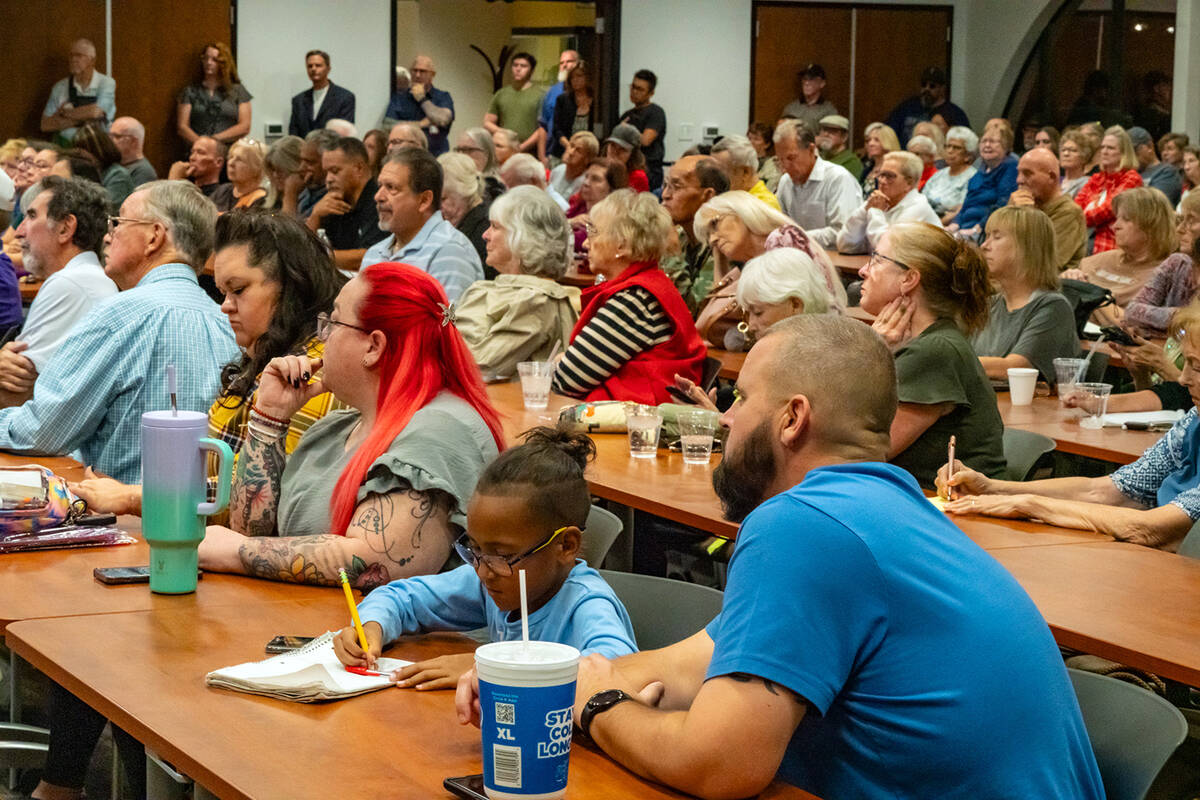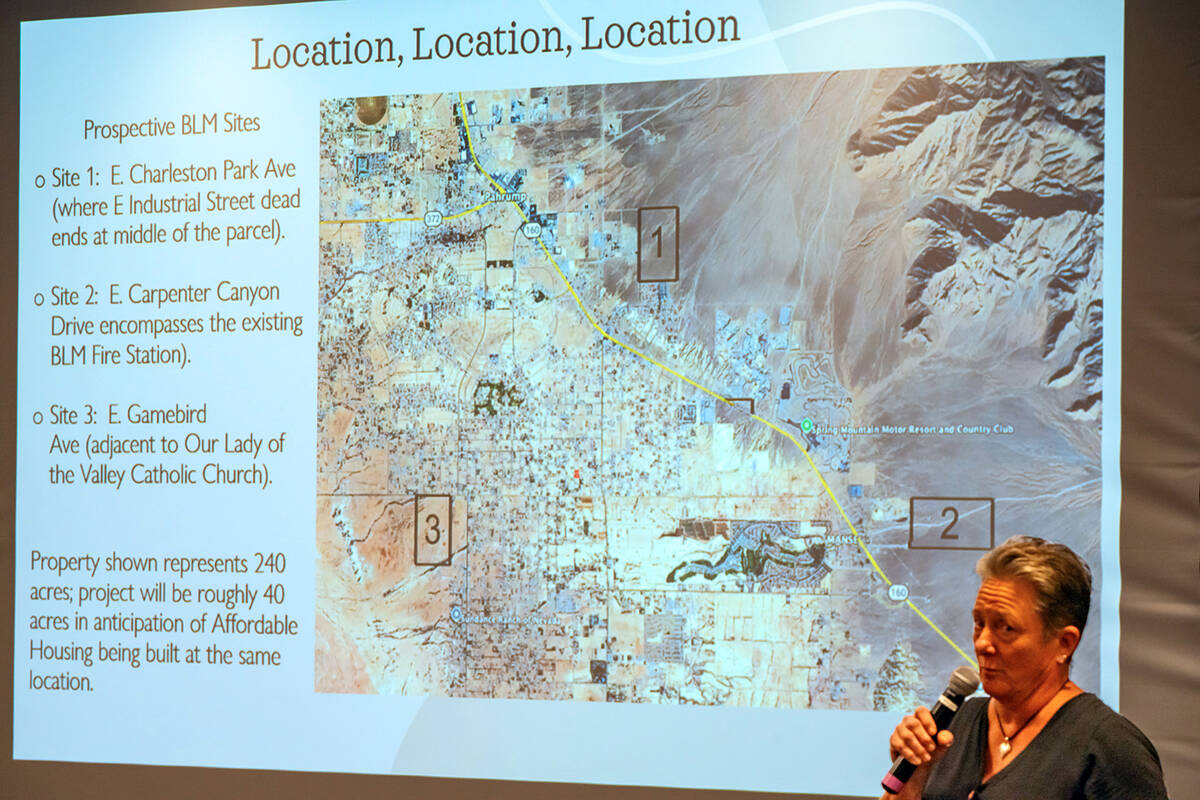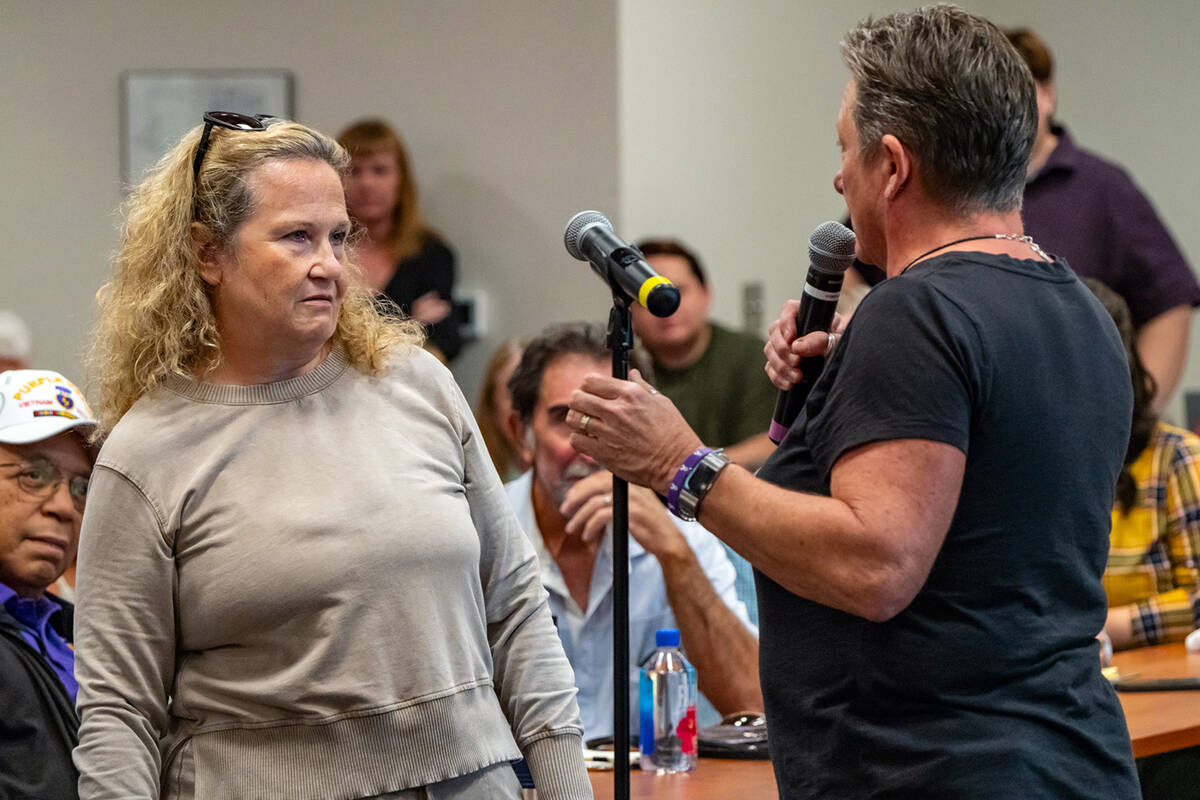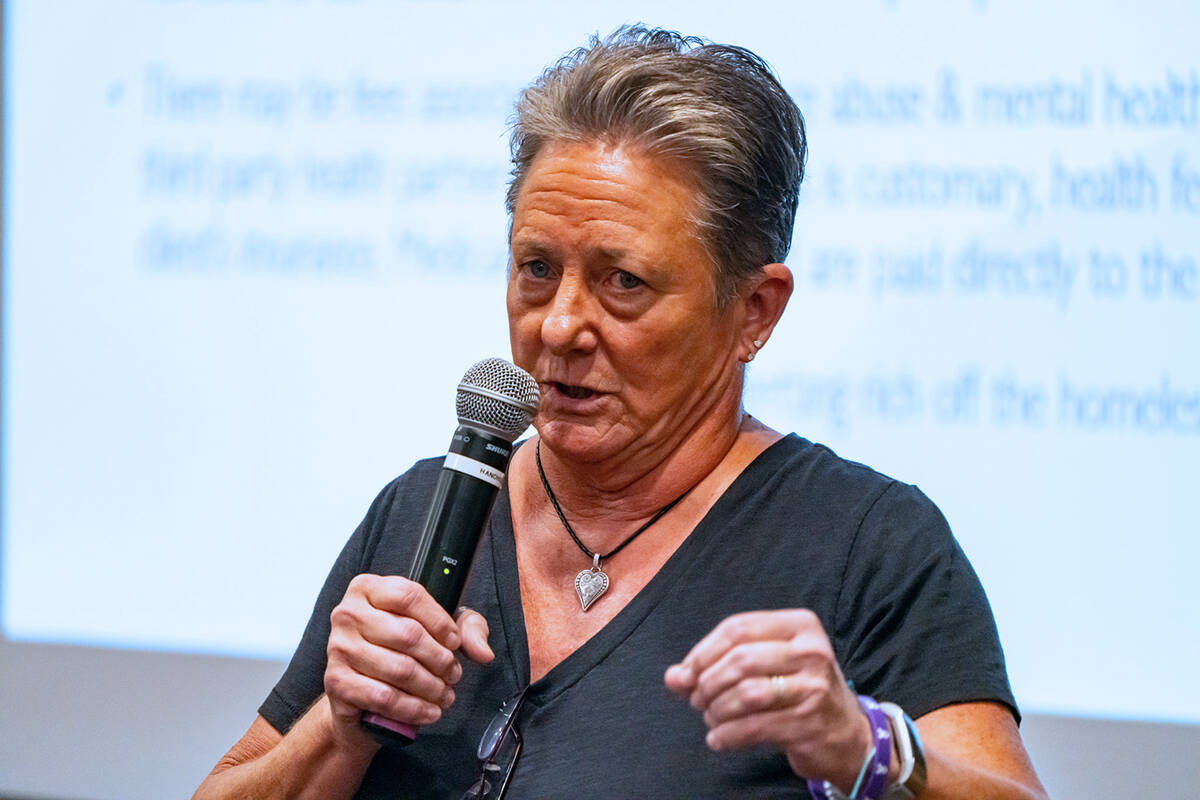Proponents present Pahrump homeless shelter proposal
It was standing-room-only inside the Valley Electric Conference Center as around 200 residents gathered for a Community Town Hall on a proposal to build a local homeless shelter and soup kitchen. Every seat was taken and many attendees lined the walls as those leading the charge on the project readied themselves to offer explanations and field questions.
But despite a lengthy overview of what’s in the works, it appears that the event did little to change the minds of those who had already decided to oppose the project. It wasn’t all negativity, however, with several attendees turning out to speak in favor of an effort that they feel is a long time coming.
Part one of this two-part series provides coverage of the project presentation while part two will delve into the audience question-and-answer portion of the meeting.
Taking place Wednesday, Oct. 23, the Homeless Shelter Community Town Hall was hosted in conjunction between Nevada Outreach Training Organization and the NyE Communities Coalition (NyECC), the two nonprofits heading up what’s been dubbed the Transitional Housing and Nutrition Center (THNC).
The THNC is one of two signature USDA Rural Partners Network projects in Nye County, the second being a childcare center in Tonopah. In the southern end of the county, the THNC is intended to provide not only shelter for those experiencing homelessness but many other valuable services to help get them back on their feet. However, project leaders emphasized that the center is in the very beginning stages of development and there will be plenty of time for public input as the proposal moves forward.
Though there are rumors circulating to the contrary, Nevada Outreach representative Kathie McKenna stressed that to date, no money has been earmarked for the project. If the THNC manages to come to fruition, it will only be through the use of federal and state grants, she noted, adding that the project will not utilize any local Nye County tax dollars.
“This project is not a Nye County project. This is not a Nye County supported project, it is not funded by Nye County funds,” McKenna stated as the meeting kicked off.
She then gave a brief background on Nevada Outreach, which has been in operation since 1995, before NyECC CEO Stacy Smith did the same for the coalition, which was established in 2002. Nevada Outreach’s focus is aimed at its Family Resource Center, the Nye County Children’s Advocacy Center program for children who have been sexually or criminally, physically abused and the nonprofit’s best-known program, No to Abuse. NyECC was formed in collaboration with the Nye County School District and has since expanded into four specific divisions, including workforce development, wellness and prevention, deflection programming and community support.
Together, these two organizations represent over 50 years of experience in the nonprofit sector.
“What we’re trying to do is address the homeless/unhoused issue, those who are at high risk of becoming unhoused and undernourished or those who have food insecurities,” McKenna detailed Wednesday night. “We are looking at doing this by overnight, inclement weather shelter; meals and we’ll have a self-service pantry; mental health; substance abuse services; we’ll have educational services there; and there’s quite a bit more… So it’s not going to be just a homeless shelter and soup kitchen.”
Nevada Outreach and NyECC are far from the only local entities involved in the project. An advisory committee was formed in August, with more than two dozen members ranging from government officials, businesses and education representatives to faith-based organizations, private citizens and other nonprofits. Through the Rural Partners Network, this advisory committee has a direct link to an array of federal agencies that can help move the project forward, of which there are 20.
“We’ve had the administrator of HUD actually in Pahrump to talk with us, we’ve had the administrator from the USDA, the White House has come down, it’s been quite impressive,” McKenna reported.
Shortly after forming the advisory committee, a concept paper was published outlining what the THNC is aiming for, which is available at the Nevada Outreach website.
Turning to the more controversial side of the matter, McKenna attempted to dispel a variety of what she says are myths, including public belief that the homeless population is mostly made up of transplants, the project will constitute a for-profit halfway house, homeless people will flock to town if the shelter is built and more. None of these ideas are accurate, McKenna asserted.
“Probably the biggest issue we seem to have is, people think they know, but they aren’t sure. Someone posts on social media because they think they know, but they’ve never asked,” McKenna said. “So we need to stop and take a hard look at the homeless.”
Via surveys conducted with 47% of Nye County’s total homeless population of 110 unsheltered individuals, it was determined that the average length of Nevada residency was 15 years while the average time as a Nye County resident was 10 years. The average length of time spent homeless was just over four years, which correlates to the exact time period when the COVID-19 pandemic was ravaging the country. Currently, there are 95 homeless Nye County residents on the waiting list for housing assistance.
“These are our community members folks,” McKenna stated. “They are already here. And you know what? They have been here for years. Our numbers started out small and they are getting larger… Long-term evidence shows that no, it does not bring people here.”
There was an outburst of muttering at this but McKenna pushed on.
As to the concerns about using grants to fund the operation, Nevada Outreach and NyECC are both well-versed in relying on such a funding stream. “Guess what? We have money run out all the time. And what do we do? We find different grants. If we have to cut back, we cut back. We do what it takes to make our operations work,” McKenna explained.
She also added that the THNC will not charge any of its clients fees for housing, food or other provided services. The only exception would be charges made to Medicare or Medicaid for health care, which would be paid to the medical professionals rendering care, not the THNC.
The advisory committee is hoping to create outdoor facilities for the THNC as the first phase of construction, to incorporate shelter, hardened tables and chairs, a playground, pet relief and activity area, bathrooms, water access, a courtyard with trees, Wi-Fi service and device charging, security and even a community garden.
Once this is built, the committee will look toward the shelter facility itself, which will include separate wings for women, men, families, unaccompanied minors and domestic violence victims. Those staying in the general women’s and men’s wings would be offered overnight stays, while families, unaccompanied children and domestic violence victims would be allowed to stay throughout the day. With a full complement of outdoor facilities, the committee is hopeful that those who utilize the shelter will stay on site as well.
Perhaps one of the greatest points of interest for attendees was the location aspect of the project. At the moment, the advisory committee is working with the Bureau of Land Management to secure what are termed “disposal lands”, with three large parcels under consideration. These include a site at E. Charleston Park Ave., east of the KPVM TV offices, E. Carpenter Canyon Drive on a parcel encompassing the existing BLM Fire Station and E. Gamebird Road, adjacent the Our Lady of the Valley Catholic Church. Each parcel is approximately 240 acres but the advisory committee intends to develop only 40 acres.
Not all of those 40 acres will be for the THNC, though. The plan is to allow room for builders to come in and construct affordable housing that can provide residents and those utilizing the THNC with rental prices within their budget.
“I don’t know how many people here have tried to rent a place lately but it’s difficult,” McKenna said. “We’ve got camping trailers renting for $900 a month, plus electricity. I have senior citizens who walk through my door who only make $700-$800 a month. You can’t make that math work.”
Affordable housing, she noted, is not Section 8 housing or free housing. “Affordable housing is where an individual or family pays 30% of their income,” she explained. “And the other problem you run into is down payments and deposits… If we had affordable housing, we might not need a shelter… Getting them housed is the biggest step. Doesn’t sound like it works but there are years of studies to show that it does.”
Following the formal presentation, it was residents’ turn to take the spotlight and dozens eagerly stepped up to speak. Readers can look for coverage of the question-and-answer session with audience members in an upcoming edition of the Pahrump Valley Times.
For more on the THNC project visit NevadaOutreach.org
Contact reporter Robin Hebrock at rhebrock@pvtimes.com
Don't miss part two, in Wednesday's edition
It was standing-room-only inside the Valley Electric Conference Center as around 200 residents gathered for a Community Town Hall on a proposal to build a local homeless shelter and soup kitchen. Every seat was taken and many attendees lined the walls as those leading the charge on the project readied themselves to offer explanations and field questions.
But despite a lengthy overview of what's in the works, it appears that the event did little to change the minds of those who had already decided to oppose the project. It wasn't all negativity, however, with several attendees turning out to speak in favor of an effort that they feel is a long time coming.
Part one of this two-part series provides coverage of the project presentation while part two will delve into the audience question-and-answer portion of the meeting.




















